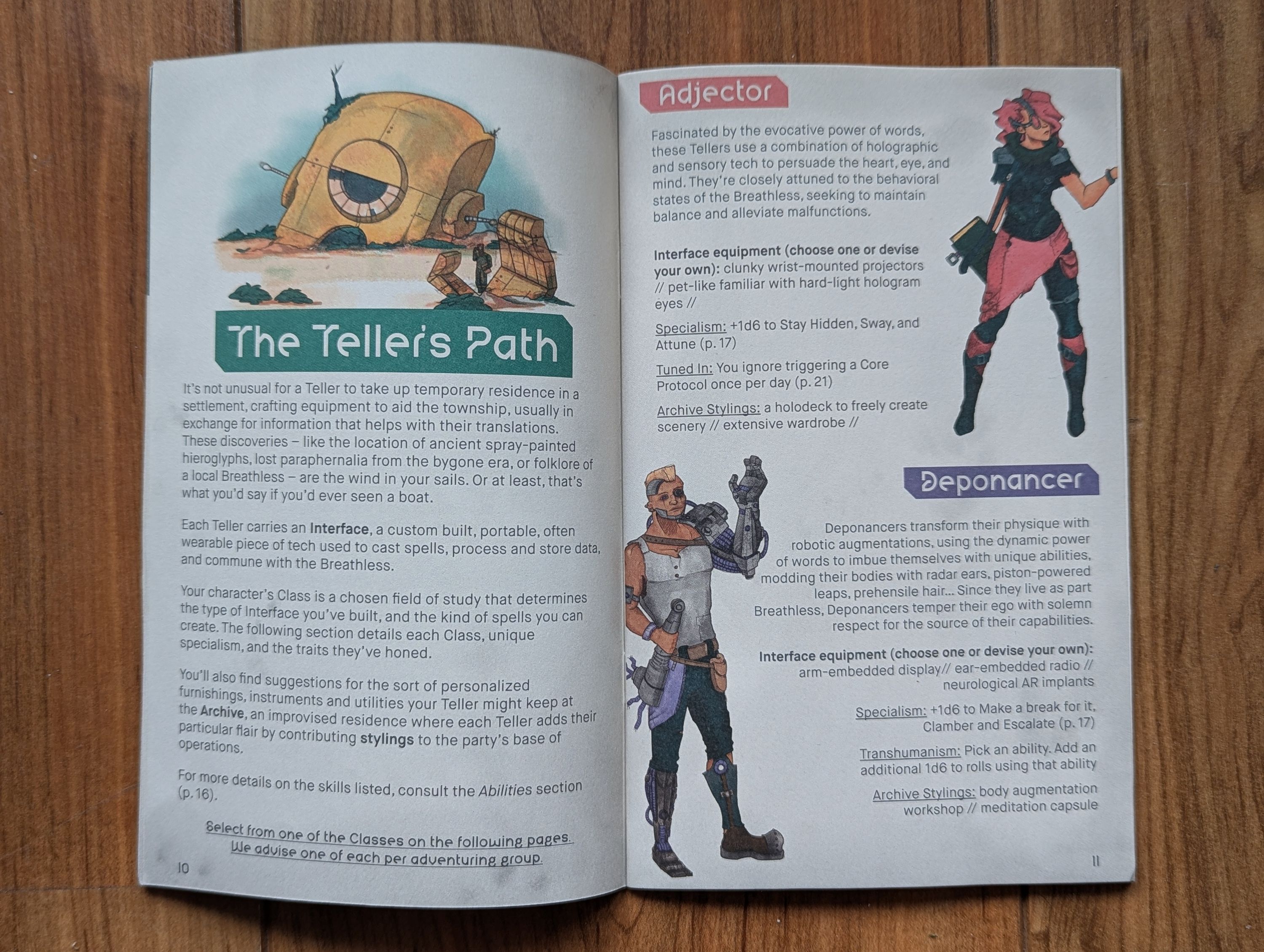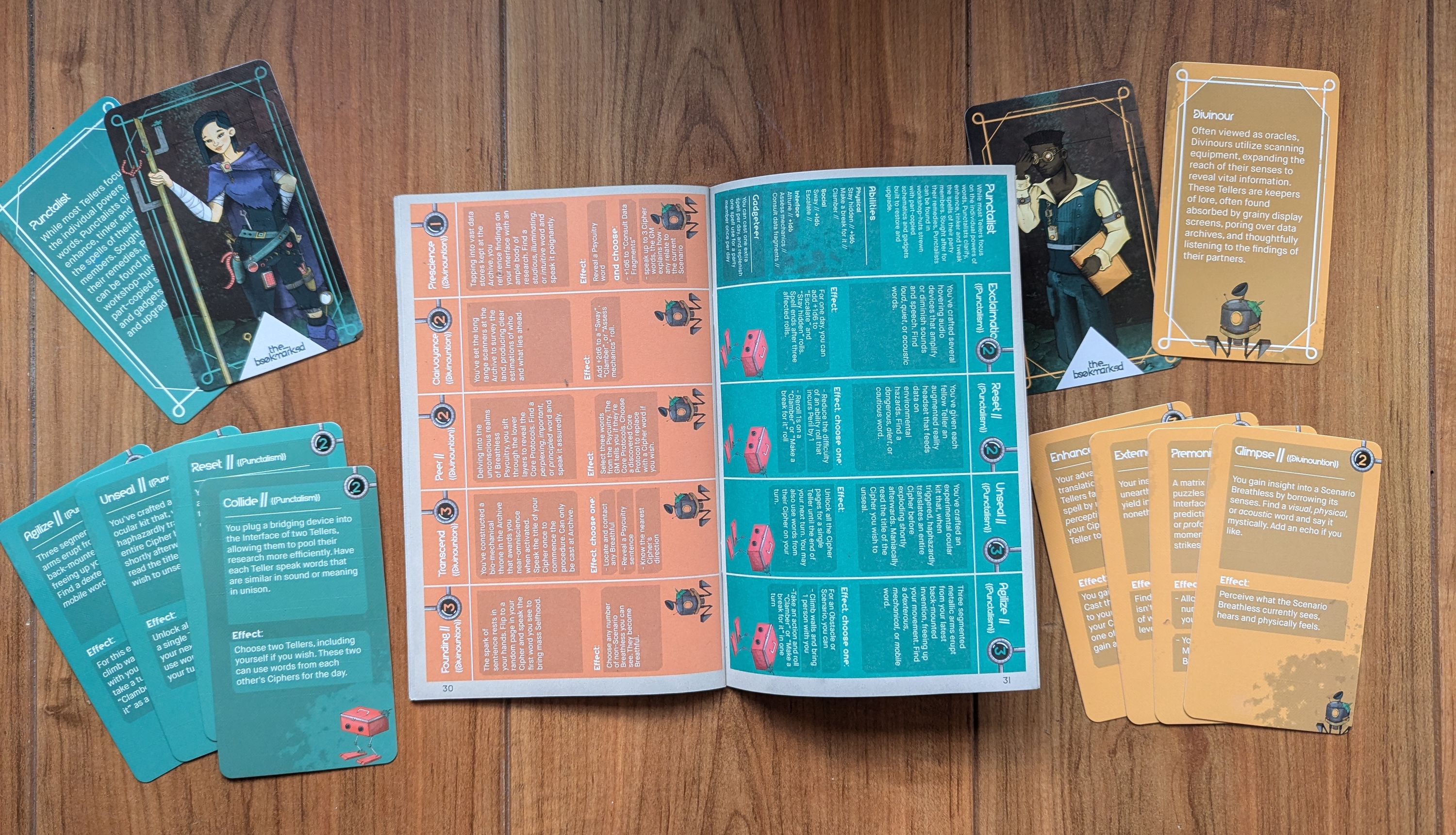ReadLog: The Bookmarked
I picked up this booklet after hearing the game’s pitch it at Tabletop Scotland last month. Tell me it isn’t intriguing: you play a post-apocalyptic spellcaster who frees ancient robots of the obsolete programming they have been stuck in for centuries. Your spellbook is a real-life book taken from your bookshelf, in which your store your spells as bookmarks.
 everything I got, minus the stickers
everything I got, minus the stickers
It’s a 36-page zine with 12 pages of spell bookmarks and scenario tables. It has a clear layout, very legible type despite the off-white textured background, and the art by Amber Oppel helps communicate the whimsical cuteness of the world. The design is by Freddie Watkins and Andrew Marks, with help from Liam Summers and Kyle Puller.
Tellers and Cyphers
The zine starts with a short introduction about the setting before diving into world and character creation. The former is done freely in conversation, with one simple rule: contrast the fallen human world with the onset of nature in every sentence. The latter requires players come up with a motivation and origin for their characters (the tellers), drawing inspiration from the book they brought to the game (known in the world as their cypher. There are no guidelines for choosing the books: it can be War and Peace, it can be Rolemaster’s Spell Law, the King James bible, or a Nigella cookbook. I can only imagine the diversity of characters one can have. Note that this isn’t a multiversal RPG: the characters aren’t borrowed from the book Jasper Fforde style. They’re native to the post-apocalyptic era, but they have grown with the book they’ve found in the ruins and have evolved with it.
 two classes per page
two classes per page
Interestingly for such a small game, The Bookmarked has classes: adjector, deponancer, divinour, punctualist, and breathful (a freed robot, which the authors recommend you don’t play initially). This isn’t 5E though: each class and its illustration take up half a page — they get a bonus to one type of action and a special ability, along with some flavour choices. No attributes, no skills, no numbers. The character sheet is the book and the spell bookmarks inside it (each class starts with a double-sided bookmark containing two spells).
Non-violent mechanics
The resolution system is d6 based: roll four dice, plus any bonus dice from your class, and each 4+ is a success. The main things you do are strictly defined : three physical actions, two social actions, and three interface actions. Interestingly, you can hide and run away but not fight, you can influence and threaten but not damage psychologically. I mean, I can’t stop you from trying to do this things, but no class gives bonuses to your rolls (and there aren’t any NPC stats or hit points or wounds system, this game really doesn’t want you to get violent). Player characters can die however: there is a multi-roll save mechanic called peril that is invoked when they fail an action with potentially dangerous consequences.
Psycuitry and the Breathless
Each scenario is centred around a breathless, an ancient robot that is carrying on its centuries old programming, negatively affecting the world and a community living nearby. Confronting the breathless to get it to break free of its programming and finally become sentient (and a breathful, then) is the final scene of each adventure and a mini-game in itself.
Depending on its current states (operational or damaged and friendly or defensive), a robot does different things, and different actions can be attempted against it. To win, the players must help the breathless achieve selfhood by pushing it to do three actions from a list divided into self-determination, self-awareness, and autonomy. They do so by rewriting its programming (an action called psycuitry), using their book’s words to change the three sentences that compose said programming (and that they’ve hopefully discovered in the adventure leading to the confrontation). The words must appear on the pages marked by one of the player’s spell.
If they fail to do this before the robot gets both damaged and defensive, it locks down or leaves and the characters have to wait, and deal with the fallout of an unchecked robot doing crazy things and worsening the local’s lives. Maybe they didn’t investigate enough before confronting the breathless, and they didn’t know enough about its original programming to tweak it efficiently.
Having not played yet, it looks like a good balance of mechanics and fictional positioning. You track the robot’s states and the programming sentences you’ve deducted, but the situation dictates what you can do just as much.
Scenario building
The zine ends with tightly packed tables to build your adventures: 11 scenarios and 45 obstacles. The GM uses these tables as a base for their locations, settlements, communities, NPCs, etc. Some entries have symbols to indicate they work well together in a series of scenarios.
These tables are detailed and atmospheric. They do the heavy lifting in communicating the game’s mood. There are stylist robots pillaging vital resources to create ever more beautiful outfits, weather balloon robots, sports team mascot robots. More Saturday morning cartoon than Terminator.
 the tables and their corresponding cards
the tables and their corresponding cards
Village on Stilts has published the tables as a deck of cards (which I bought, of course), and there is a tarot-size deck containing each class’ bookmark spells. These are in the book, laid out so you can cut them out but of course I bought that too. Along with a few cute robot stickers, I was given a pamphlet with a scenario, which helped me understand how much context is needed to the tables entries/cards (which is not very much).
tl;dr
A non-violent post-apocalyptic game with a lot of flavour (and perhaps too many neologisms but that’s just me). Simple and innovative mechanics. Starts at £7 in PDF on Village on Stilt’s website. I’ll definitely keep it at hand in case there’s an opportunity to play it in person!
 the bookmarks are nicer as tarot cards, as you would have guessed
the bookmarks are nicer as tarot cards, as you would have guessed